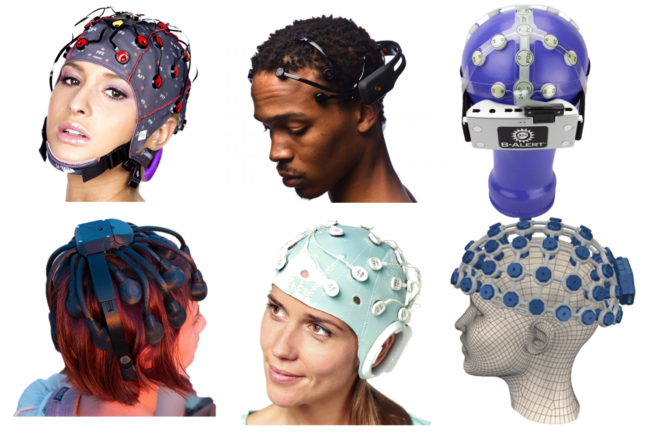With shrinking electronics and wireless technology, EEG devices are getting portable, and cheaper
Commercial EEG or electroencephalogram machines, devices capable of measuring electrical signals in the brain, have typically been cumbersome and complicated devices. (read our earlier post Decoding the Electric Brain for a history of the discovery of the EEG). The nature of the equipment forced studies to fixed locations in a lab or hospital.
Even today, most EEG experiments are still largely conducted within the lab or hospital environment. If you have ever been a participant in an EEG study or a patient getting an EEG, you will likely have been attached to the device by electrodes connected to dozens of wires painstakingly adhered individually to your scalp with a cold, sticky gel. A 10 minute recording of your brain activity could take up to an hour to set up, and rather than go back to work or to your next meeting, you would probably have to go home and wash your hair instead.
More significantly though, these systems cost anywhere from $20,00 to $100,000, making it an expensive proposition. This is all changing with advances in wireless technology and microelectronics.
From Wired to Wireless
There is a shift today towards lower cost, portable devices that takes EEG out of the lab and into the world. The two major factors that are driving this shift are the increasingly small size of the electronics, and wireless technologies such as Bluetooth. With electronics shrinking in size and weight, instead of being housed in a huge heavy casing that takes two hands to lift, it can be fitted on a headset or cap. Wireless technology then allows the recording device to be detached from the computer, instead signaling to it from a distance of up to 10 or sometimes 20 meters.
To keep the device portable, the number of channels, or locations that they measure, are fewer – ranging from 8 to 32 compared to the 32 to 256 that you typically have in the fixed devices. They also come with lower digital sampling rates to enable efficient wireless streaming – typically 125 or 256 Hz or samples per second rather than the 1000 Hz that the fixed systems support. However, with these compromises also comes the benefit of lower cost with devices ranging from $25,000 for the high end configurations to as low as $1200.
Faster Set-up
The next innovation is in the set up time. The headsets and caps help quickly position the electrodes and reduce the set up time by allowing the electrodes to be fitted all together instead of one at a time. More importantly sensor technology has improved and there are now some devices with dry electrodes that work almost as well as the ones that require gel or paste. This makes it much quicker to pop on and off and devices can get up and running with a stable signal in just a few minutes compared to the much longer set-up of the traditional systems. All together this makes experiments faster, more friendly and easier to manage.
Expanded Possibilities
Today there are only a handful of portable (cap or headset mounted) EEG devices on the market that can be used for research from the 50 or so EEG manufacturers out there (at least that’s what we counted and its quite possible we missed a few). As you can see they come in all sorts of looks, but essentially measure the same signal. Some are more suited to ambulatory measurement by providing the more secure cap that keeps the electrodes more stable. There are of course differences in signal sampling and quality which we will address in different posts.
The space is evolving and companies are positioning their hardware in the market quite differently – from using it as a pure research tool or a clinical tool for real time seizure detection, to consumer applications such as stress reduction and video gaming. Bottom line though, they allow you to take the experiments out of the lab, do them faster and cheaper, and increasingly, under circumstances where people are moving around doing their daily activities. This immensely expands the scope of research.
Here is a list of wireless EEG devices that are suitable to use for research – in general the more the number of channels and the higher the sampling rate, the more expensive it will be. (We are not covering the single to five channel consumer devices here – more on those later).
| Company | Product Name | No. of Channels | Digital Sampling Rate (Hz) | Location |
|---|---|---|---|---|
| Cognionics | Mobile-72 Wireless EEG System | 16/24/32/64 | 500/1000 | San Diego, CA |
| Quick 20 Dry EEG Headset | 20 | 500 | ||
| Multi Position Dry EEG Headband | 8 | 250/500/1000 | ||
| gtec.at | g.Nautilus* | 8/16/32/64 | 250/500 | Scheidlberg, Austria |
| Neuroelectrics | STARSTIM* | 8/20/32 | 500 | Barcelona, Spain |
| ENOBIO | 8/20/32 | 500 | ||
| Mitsar | Smart BCI Headset | 23 | 250 | St. Petersburg, Russia |
| Advanced Brain Monitoring | B-Alert X | 10/24 | 256 | Carlsbad, CA |
| Stat-X | 10/24 | 256 | ||
| OpenBCI | UltraCortex | 8/16 | 125 | New York, NY |
| Emotiv | EPOC | 14 | 128 | San Francisco, CA |
*indicates the electrodes are stimulating. More about these in another post.


















